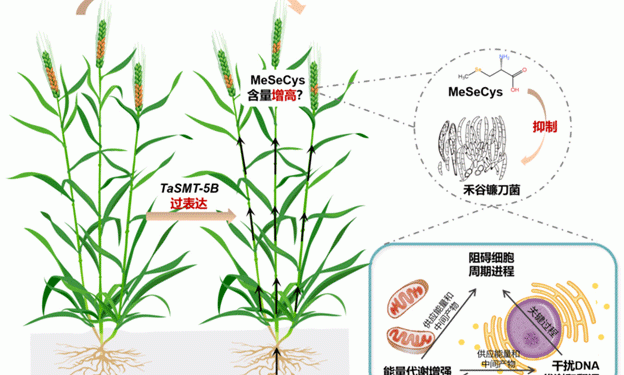Professor Li Tao’s research team at Yangzhou University has made significant strides in enhancing wheat resistance to Fusarium head blight. After years of research, the team identified a crucial gene, TaSMT, involved in wheat’s resistance to FHB. This breakthrough was further developed in collaboration with Professor Yu Lei’s team from the School of Chemical Engineering at Yangzhou University, leading to the creation of a cost-effective and efficient biostimulant: methylselenocysteine glucose.
Methylselenocysteine, an organic selenium compound, has been found to significantly increase wheat’s resistance to FHB. In experimental treatments, wheat plants sprayed with methylselenocysteine showed a notable reduction in disease severity and toxin levels in the grain. This compound appears to work by interfering with fungal DNA metabolism and translation, thereby disrupting the fungal cell cycle and inhibiting its growth.
Addressing High Costs and Improving Efficacy
Traditionally, organic selenium compounds like methylselenocysteine have been prohibitively expensive, limiting their widespread use in agriculture. Recognizing this challenge, Professor Li Tao’s team, in collaboration with Professor Yu Lei, developed a more affordable alternative: methylselenocysteine glucose. This new compound not only reduces production costs but also enhances selenium biofortification in wheat, achieving 2-3 times the selenium content compared to inorganic selenium treatments.
The team’s innovative approach has several advantages:
- Cost-Effectiveness: Methylselenocysteine glucose is cheaper to produce than other organic selenium compounds, making it more accessible for large-scale agricultural applications.
- Enhanced Efficacy: It significantly boosts selenium content in wheat grains, which can improve nutritional value and help mitigate FHB.
- Safety and Sustainability: The production process for methylselenocysteine glucose is designed to be safe and environmentally friendly, contributing to sustainable agricultural practices.
Implications for Wheat Farming and Food Security
The discovery and development of methylselenocysteine glucose represent a significant advancement in the fight against Fusarium head blight. By improving wheat’s resistance to this destructive disease, farmers can expect better crop yields and reduced reliance on costly and potentially harmful chemical treatments. Furthermore, the increased selenium content in wheat could offer additional health benefits, as selenium is an essential nutrient that supports immune function.
This research not only addresses an urgent need in disease management but also aligns with broader goals of enhancing food security and sustainability in agriculture. As climate change and global agricultural challenges continue to evolve, innovations like these will be crucial for adapting and ensuring resilient food systems.
Yangzhou University’s groundbreaking research on methylselenocysteine glucose provides a new, cost-effective solution for managing Fusarium head blight in wheat. This development marks a significant step forward in improving crop resilience and food security, offering hope for more sustainable and effective agricultural practices. Continued exploration and application of these findings will be essential in combating wheat diseases and supporting global food systems.
Error




